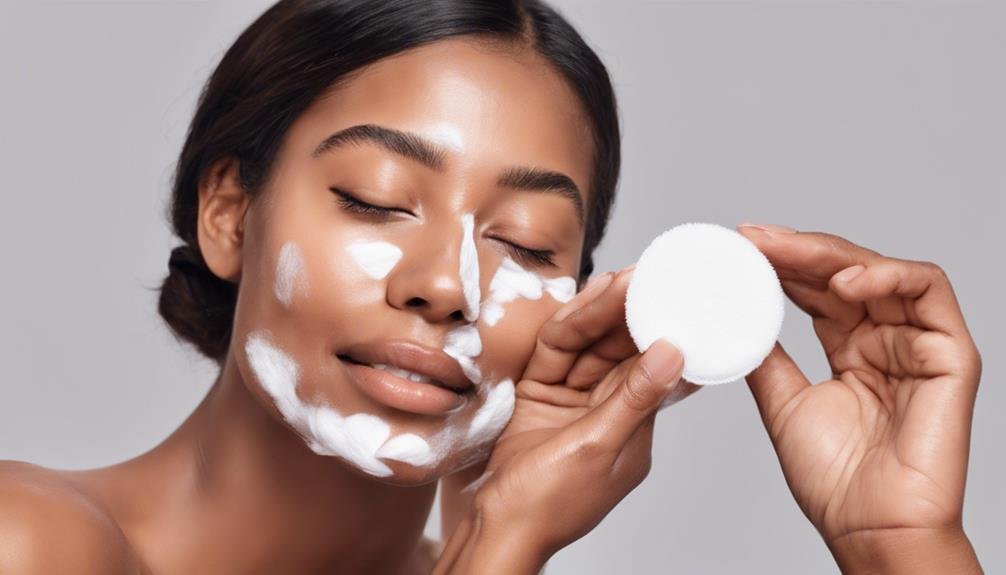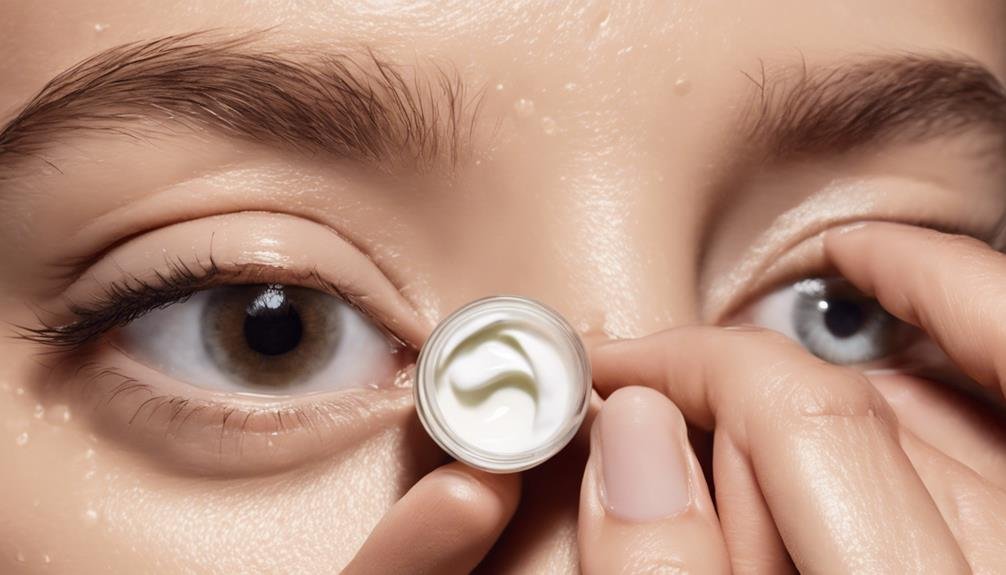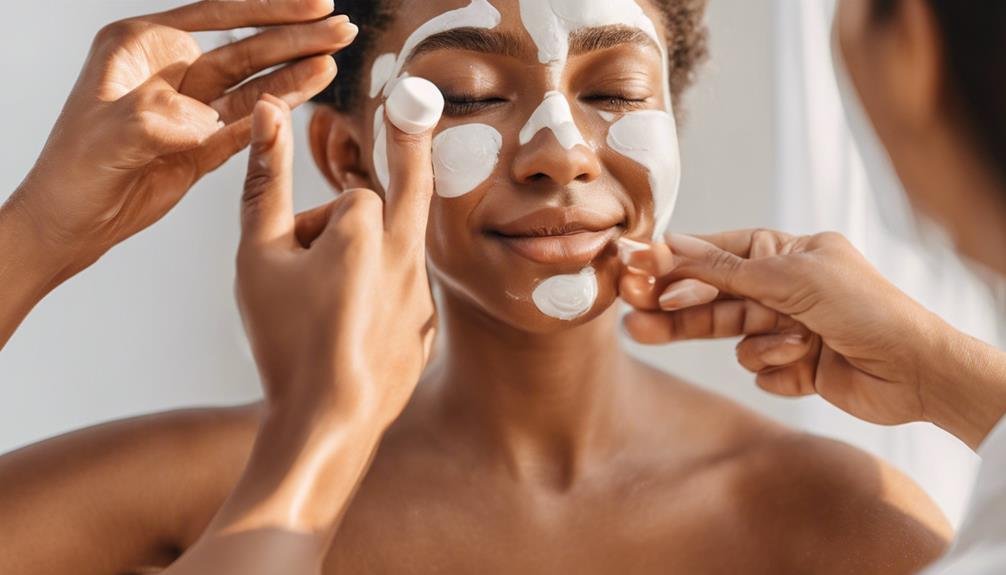So, you've decided to dip your toes into the vast world of skincare, and you're ready to embark on this journey toward healthier skin. But where do you even begin? Well, let's start by breaking down the essential steps that will lay a solid foundation for your skincare routine. From cleansing to toning, each step plays a crucial role in nurturing your skin and addressing its needs. But remember, there's more to uncover beyond these basics that can elevate your skincare game to the next level. Stay tuned to discover how you can take your routine from good to great.
Key Takeaways
- Start with a gentle cleanser to remove impurities.
- Incorporate exfoliation 1-3 times weekly for smoother skin.
- Use a toner to balance skin pH and hydrate.
- Apply a targeted serum to address specific skin concerns.
- Don't forget eye care with a hydrating eye cream.
Cleansing
Looking to achieve healthier, clearer skin? Cleansing is a crucial step in any skincare routine. It helps remove dirt, oil, and impurities that can clog pores and lead to breakouts.
When choosing a cleanser, opt for a gentle formula that suits your skin type. For dry skin, a hydrating cleanser with ingredients like hyaluronic acid can help retain moisture. If you have oily skin, look for a foaming cleanser with salicylic acid to unclog pores.
To cleanse effectively, start by wetting your face with lukewarm water. Apply a small amount of cleanser to your fingertips and gently massage it onto your skin in circular motions. Be sure to avoid harsh scrubbing, as this can irritate the skin. Rinse thoroughly with water and pat your face dry with a clean towel.
Make cleansing a part of your morning and evening routine to keep your skin looking its best. Remember, a clean canvas sets the foundation for the rest of your skincare regimen.
Exfoliation
To maintain healthy and radiant skin, incorporating exfoliation into your skincare routine is essential. Exfoliation helps remove dead skin cells, unclogs pores, and promotes cell turnover, leading to smoother, brighter skin.
There are two main types of exfoliation: physical and chemical. Physical exfoliants use granules or tools to physically slough off dead skin cells, while chemical exfoliants use acids or enzymes to dissolve them.
When choosing an exfoliant, consider your skin type. Sensitive skin may benefit from gentle exfoliants like oatmeal or enzyme-based products, while oily skin may require stronger exfoliants like salicylic acid.
It's crucial to exfoliate no more than 1-3 times per week to avoid irritating the skin. Over-exfoliation can strip the skin of its natural oils, leading to dryness and sensitivity.
Always follow exfoliation with a hydrating moisturizer to replenish moisture and keep your skin balanced. Remember, consistency is key when it comes to exfoliation for healthy, glowing skin.
Toning
For those new to skincare, understanding the importance of toning is crucial in achieving balanced and radiant skin. Toning is a vital step that helps to remove any remaining traces of dirt, makeup, or impurities that your cleanser might've missed. It also helps to restore your skin's pH balance, which can be disrupted by harsh cleansers. Additionally, toners can help to hydrate, soothe, and prepare your skin to better absorb the following skincare products.
When choosing a toner, opt for alcohol-free formulas to prevent drying out your skin. Look for toners with ingredients like witch hazel, rose water, or aloe vera, which can help to calm and refresh your skin.
To apply toner, pour a small amount onto a cotton pad and gently swipe it across your face and neck after cleansing. Be sure to follow up with a moisturizer to lock in the benefits of your toner and keep your skin hydrated and supple.
Serum Application
When incorporating serums into your skincare routine, you're introducing potent formulations packed with active ingredients that target specific skin concerns. Serums are designed to penetrate deeply into the skin, delivering concentrated doses of beneficial ingredients such as vitamins, antioxidants, and hyaluronic acid.
To apply a serum effectively, start with a clean face after cleansing and toning. Dispense a pea-sized amount of serum onto your fingertips and gently press it into your skin, starting from the center of your face and moving outwards. Allow the serum to fully absorb before applying moisturizer to lock in the benefits.
It's important to choose a serum that addresses your specific skin needs, whether it's hydration, brightening, anti-aging, or acne-fighting properties. Remember that a little goes a long way with serums, as they're highly concentrated.
Incorporating a serum into your routine can help enhance the overall health and appearance of your skin, providing targeted solutions for your skincare concerns.
Eye Cream
Unlock the secret to refreshed and youthful-looking eyes with the power of eye cream. The delicate skin around your eyes is prone to dryness, fine lines, and puffiness, making it essential to incorporate an eye cream into your skincare routine. Eye creams are specially formulated to address these concerns, providing hydration, reducing the appearance of wrinkles, and combating dark circles.
When choosing an eye cream, look for ingredients like hyaluronic acid, vitamin C, retinol, and peptides, known for their powerful anti-aging and hydrating properties. These ingredients work together to nourish the skin, improve elasticity, and brighten the under-eye area.
To apply eye cream effectively, use your ring finger to gently pat a small amount around the orbital bone, avoiding direct contact with the eyes. Incorporate this step into your morning and evening skincare routine after cleansing and before moisturizing for maximum benefits.
Moisturizing
Begin by hydrating and protecting your skin with the essential step of moisturizing. Moisturizers are crucial for maintaining skin health by providing hydration, sealing in moisture, and creating a barrier against environmental stressors. When choosing a moisturizer, opt for one that suits your skin type – whether dry, oily, combination, or sensitive.
For dry skin, look for rich creams with ingredients like hyaluronic acid or shea butter. Oily skin benefits from lightweight, oil-free formulas that won't clog pores. Combination skin may require different moisturizers for various areas of the face. Sensitive skin types should choose gentle, fragrance-free options to prevent irritation.
To properly moisturize, apply a pea-sized amount to your face and neck after cleansing and toning. Gently massage the product in an upward motion to promote circulation and absorption. Remember to moisturize both morning and night to keep your skin nourished and balanced.
Regular moisturizing not only enhances your skin's appearance but also helps maintain its overall health and resilience.
Sunscreen
To effectively shield your skin from harmful UV rays and prevent premature aging and skin damage, incorporating sunscreen into your daily skincare routine is paramount. Sunscreen is a crucial step that shouldn't be overlooked in your skincare regimen.
Here are some essential points to consider:
- Broad Spectrum Protection: Opt for a sunscreen that offers broad-spectrum protection to shield your skin from both UVA and UVB rays.
- SPF Level: Choose a sunscreen with a Sun Protection Factor (SPF) of 30 or higher to ensure adequate protection against the sun's damaging effects.
- Regular Reapplication: Remember to reapply sunscreen every two hours, especially if you're outdoors or engaging in activities that may cause sweating or water exposure.
Spot Treatment
Spot treatment refers to the targeted application of specific skincare products on individual blemishes or problem areas on your skin. This step is crucial in addressing pesky acne spots or occasional breakouts.
When choosing a spot treatment product, look for ingredients like salicylic acid or benzoyl peroxide, known for their acne-fighting properties. These products work by penetrating the skin to unclog pores, reduce inflammation, and kill acne-causing bacteria.
To apply spot treatment effectively, cleanse your face thoroughly before applying a small amount directly onto the blemish. Avoid spreading the product to unaffected areas to prevent drying out healthy skin. Spot treatments are typically used at night to allow the product to work its magic while you sleep.
Remember not to overuse spot treatments, as they can cause dryness or irritation if used excessively.
Incorporating spot treatment into your skincare routine can help target specific skin concerns efficiently, giving you clearer and healthier-looking skin over time.
Face Masks
Face masks are a popular skincare treatment that can provide a myriad of benefits for your skin. They offer a luxurious and effective way to target specific skin concerns and promote overall skin health.
Here are some key reasons why incorporating face masks into your skincare routine can work wonders for your skin:
- Deep Cleansing: Face masks can help draw out impurities and unclog pores, leaving your skin feeling refreshed and revitalized.
- Hydration Boost: Some face masks are formulated to provide intense hydration, helping to nourish and moisturize your skin for a radiant complexion.
- Skin Soothing: Certain masks contain ingredients that soothe and calm the skin, making them perfect for sensitive skin types or for use after exfoliation.
Facial Oils
With the rise in popularity of skincare routines, incorporating facial oils has become a common practice among individuals seeking to achieve healthy and radiant skin. Facial oils are beneficial for all skin types, even oily skin, as they can help balance oil production and provide essential nourishment. These oils are packed with antioxidants, vitamins, and fatty acids that deeply hydrate and rejuvenate the skin.
When choosing a facial oil, consider your skin type and concerns. For dry skin, opt for oils like argan or marula that are rich in moisture-locking properties. If you have sensitive skin, look for gentle oils like chamomile or jojoba to soothe and calm irritation. Oily skin can benefit from lighter oils such as rosehip or squalane that won't clog pores.
To incorporate facial oils into your routine, apply a few drops to clean, damp skin before moisturizing. You can also mix a few drops into your moisturizer for an extra boost of hydration. With consistent use, facial oils can help improve skin texture, tone, and overall health, giving you that coveted radiant glow.
Lip Care
As you focus on enhancing your skincare routine, don't overlook the importance of lip care. Your lips need attention and care just like the rest of your face. Here are some essential steps to keep your lips soft, smooth, and healthy:
- Exfoliate: Gently exfoliate your lips once or twice a week to remove dead skin cells and promote better absorption of lip products.
- Hydrate: Keep your lips moisturized throughout the day with a hydrating lip balm containing ingredients like shea butter or coconut oil.
- Protect: Remember to apply a lip balm with SPF before heading out to shield your lips from the damaging effects of the sun.
Night Routine
During your evening skincare routine, the night is the opportune time to rejuvenate and replenish your skin after a long day of exposure to environmental stressors. Establishing a consistent nighttime regimen can aid in repairing and nourishing your skin while you sleep, promoting a healthy complexion. Here are some essential steps to incorporate into your night routine:
| Step | Description | Benefits |
|---|---|---|
| Cleansing | Gently cleanse your face to remove dirt, makeup, and oil. | Prevents breakouts and allows skincare products to absorb. |
| Toning | Apply a toner to balance skin pH and tighten pores. | Helps to refine skin texture and prepare it for treatment. |
| Treatment | Use serums or treatments to target specific skin concerns. | Addresses issues like fine lines, dark spots, or acne. |
| Moisturizing | Hydrate your skin with a nourishing night cream. | Restores moisture, soothes, and supports skin regeneration. |
Frequently Asked Questions
Can I Skip Sunscreen if My Moisturizer Already Has SPF?
You should not skip sunscreen even if your moisturizer has SPF. Layering products ensures adequate protection. Sunscreen shields from harmful UV rays, preventing premature aging and skin damage. Apply a generous amount of sunscreen daily.
How Often Should I Change My Pillowcase for Better Skin?
How often should you change your pillowcase for better skin? Regularly swapping it out every 1-2 weeks can help minimize bacteria buildup and prevent breakouts. Clean pillowcases promote healthier skin by reducing potential irritants.
Is It Necessary to Use a Separate Neck Cream?
You should use a separate neck cream if you want to target specific concerns in that area. Neck creams are formulated to address the delicate skin on your neck and can help improve firmness and elasticity.
Can I Use Body Lotion on My Face in a Pinch?
In a pinch, avoid using body lotion on your face. While both hydrate, facial skin is more delicate. Body lotions may be too heavy, clog pores, or cause breakouts. Opt for a lightweight, non-comedogenic facial moisturizer instead.
Should I Apply Spot Treatment Before or After Moisturizer?
You should apply spot treatment before moisturizer. This allows the targeted treatment to penetrate the skin directly without any barriers. Spot treatment can work more effectively when applied on clean skin before sealing in with a layer of moisturizer.
Conclusion
In conclusion, by following these essential skincare steps for beginners, you are on your way to achieving the glowing complexion of your dreams. Remember to stick to a consistent routine and listen to your skin's needs. With dedication and the right products, you can transform your skin into a radiant masterpiece that will make heads turn. So go ahead, pamper yourself and watch as your skin flourishes like never before.







